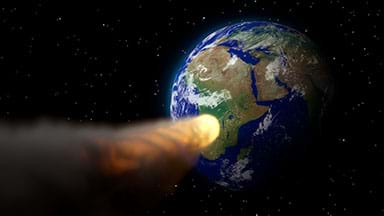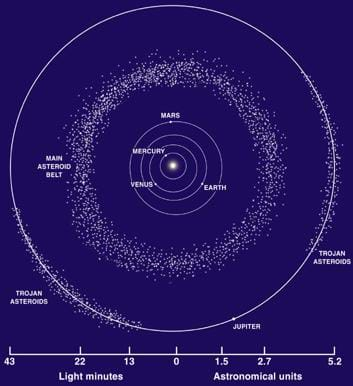Quick Look
Grade Level: 8 (7-9)
Time Required: 15 minutes
Lesson Dependency: None
Subject Areas: Earth and Space, Science and Technology

Summary
Students learn some basic facts about asteroids in our solar system, mainly about the size of asteroids and how that relates to the potential danger of an asteroid colliding with the Earth. Students are briefly introduced to the destruction that would ensue should a large asteroid hit, as it did 65 million years ago. Students are then encouraged to use the associated activity to research the impacts and potential actions to prevent such events on Earth.Engineering Connection
Engineers at NASA create technological tools to learn about asteroids. People working on the Near-Earth-Object (NEO) project study how asteroids move so we can predict whether they will hit the Earth. Software engineers design the computer programs to make these predictions. Mechanical and aerospace engineers on this project create space probes to learn more about asteroids by taking photographs of them and, in the case of the NEAR Shoemaker probe, even landing on a large asteroid.
Learning Objectives
After this lesson, students should be able to:
- Explain what asteroids are and compare them to other objects in the solar system.
- State how big an asteroid must be to cause mass destruction on Earth.
- Explain why engineers design technological tools to predict the movement of asteroids.
Educational Standards
Each TeachEngineering lesson or activity is correlated to one or more K-12 science,
technology, engineering or math (STEM) educational standards.
All 100,000+ K-12 STEM standards covered in TeachEngineering are collected, maintained and packaged by the Achievement Standards Network (ASN),
a project of D2L (www.achievementstandards.org).
In the ASN, standards are hierarchically structured: first by source; e.g., by state; within source by type; e.g., science or mathematics;
within type by subtype, then by grade, etc.
Each TeachEngineering lesson or activity is correlated to one or more K-12 science, technology, engineering or math (STEM) educational standards.
All 100,000+ K-12 STEM standards covered in TeachEngineering are collected, maintained and packaged by the Achievement Standards Network (ASN), a project of D2L (www.achievementstandards.org).
In the ASN, standards are hierarchically structured: first by source; e.g., by state; within source by type; e.g., science or mathematics; within type by subtype, then by grade, etc.
International Technology and Engineering Educators Association - Technology
-
Explain how knowledge gained from other content areas affects the development of technological products and systems.
(Grades
6 -
8)
More Details
Do you agree with this alignment?
State Standards
Colorado - Science
-
Describe methods and equipment used to explore the solar system and beyond
(Grade
8)
More Details
Do you agree with this alignment?
-
Recognize that mathematical models are used to predict orbital paths and events
(Grade
8)
More Details
Do you agree with this alignment?
Worksheets and Attachments
Visit [www.teachengineering.org/lessons/view/cub_space8_lesson03] to print or download.Introduction/Motivation
In the 1998 hit movie "Armageddon," an asteroid the size of Texas is on a collision path with Earth and is predicted to destroy all life as we know it. How real is this scenario? Well, we will answer that question today, but first, let's look at some background information about asteroids.
Asteroids are objects that revolve around the Sun, mostly in the region between Mars and Jupiter known as the asteroid belt (see Transparency #1; also shown in Figure 2).

How big are asteroids? (Listen to student ideas.) Their sizes can be quite variable! The smallest known asteroid is 6 m (or, almost 20 ft.) across—it could easily fit in our classroom. The Gaspra Asteroid (show Transparency #2; same as Figure 1) is 17 km (or, more than 10.5 miles!) across. How big is that? Could we fit a city block, small town, a big city, our state, or the whole country across something that big? (Have students raise their hands for a quick vote. Answer: A small town.) More than 200 asteroids in the belt between Mars and Jupiter are more than 100 km across. If we were to drive 100 km from our school, where would we end up? (100 km = ~62 miles. Be prepared to have location examples for students, depending on where you live. This helps students understand the scale.)
What would happen if one of these asteroids hit the Earth? (Listen to student ideas). Have students simulate their predictions of such events with the Earth Impact activity. Well, it depends on its size. Those that are less than 40 m across (about as big as a small office building) would be destroyed by the Earth's atmosphere and not do any damage. If one as large as 2 km in diameter hit the planet, it might cause disaster on a global scale. Not only would its crashing pieces cause instant destruction and death, but the dust created by the crash would set off a change in weather that would kill a huge fraction of all the living things on Earth. It is believed that this is what happened 65 million years ago when a meteor 6 miles across hit the Chicxulub Basin in Mexico, resulting in mass extinction, including dinosaurs.
Fortunately, scientists predict that your chances of being killed by an asteroid impact are very low (1 in 40,000). Currently, no known asteroids are on a collision path with Earth. However, every 1 or 2 million years, the Earth could be hit by an asteroid large enough to cause global destruction and kill most people on Earth. To prevent this, engineers are seeking ways to destroy or divert asteroids before they hit us (just like in the movie "Armageddon")!
Lesson Background and Concepts for Teachers
Asteroid Fast Facts
Asteroids are objects ranging in size from 6 m to 933 km across that revolve around the Sun. The asteroid belt contains millions of asteroids that are less than 1 km in diameter. More than 750,000 are bigger, and of those, at least 200 are more than 100 km across. Asteroids in the outer part of the belt are composed mainly of carbon, while those located in the inner part of the belt are made primarily of minerals, since they are derived from melted objects.
Although scientists are not certain how they came about, it is believed that they are the result of collisions of much larger objects occurring around the time that our solar system was formed. Some asteroids, on the other hand, are derived from the tails of comets.
History of Asteroid Collisions with Earth
Researchers at NASA have been actively tracking near Earth asteroids (NEAs) to determine whether or not they will hit. Jupiter's gravitational field pulls on asteroids just enough to slowly change their trajectories. With the advancement of computer models and tracking devices (created completely, or in part, by engineers!), scientists can predict the future trajectories of asteroids. So far, they have found that no asteroids are on a collision course with Earth.
Historically, the Earth was not always so lucky. A very long time ago—65 million years to be exact—an asteroid hit an area in present-day Mexico, leaving behind a 300 km-wide crater. It is hypothesized that this asteroid caused the mass extinction of life at that time, including dinosaurs. More recently, in 1908, a smaller object (either an asteroid or comet tail) hit Siberia, destroying forested land in an area about 50 m in diameter.
Fortunately, most asteroids that come within proximity of the Earth do no damage. As small (<40 m in diameter) asteroids hit the atmosphere, they burn up, giving off the characteristic trademark of a meteor. (Meteors are small objects that have entered the Earth's atmosphere, either from comets, asteroids, or other objects in our solar system.) This also explains why the Moon looks more "beat-up" than the Earth. The Moon does not have an atmosphere, and therefore, upon collision, even small objects cause craters on the Moon.
Associated Activities
- Earth Impact - Students simulate an asteroid impact on Earth. They measure, record and graph their results and conclusions. Finally, students brainstorm ways to prevent such a catastrophe on Earth.
Lesson Closure
Scientists and engineers are very interested in near-Earth asteroids because we know that at some point in the future (even if it is a million years away), the Earth could be impacted by an asteroid collision. It is important that researchers know what to look for in order to predict and prevent asteroid impacts that could cause devastation on Earth. While many people study the solar system for its beauty and tranquility, others study it to learn about the unknown to understand and help predict our celestial movement—both good and potentially dangerous movement.
Vocabulary/Definitions
asteroid: A celestial body that orbits the Sun; ranges in size from 6 m to 933 km.
comet: A celestial body with a solid core and followed by a tail of debris; normally has a highly elliptical orbit.
meteor: A flash of light caused by particles from outer space entering the Earth's atmosphere; typically originates from asteroid collisions.
Assessment
Pre-Lesson Assessment
Voting: Ask true/false questions and have students vote by holding thumbs up for true and thumbs down for false. Tally the votes and write the totals on the board. Give students the right answers:
- T or F: The solar system consists only of the Sun, the planets, and their moons. (Answer: False; millions of asteroids exist in our solar system.)
- T or F: If an asteroid hit the Earth, it would knock everyone off the planet. (Answer: False; asteroids are much smaller than the Earth. Most asteroids burn up when they hit the atmosphere and do no damage at all. Some large asteroids have done tremendous damage, but they are still not massive enough to knock things off the planet, or to knock the Earth out of orbit.)
Post-Introduction Assessment
Idea Web: Ask students to brainstorm a list of possible consequences of an asteroid hitting the Earth. How does one of these consequences lead to another? (For instance, as the asteroid hits, it creates a crater and sends dust and debris flying, the dust obscures the Sun, less Sun causes lower temperatures, etc.). Help students see how the single event of an asteroid impact could set off a domino-like chain reaction of changes that impact life on the planet.
Lesson Summary Assessment
Question/Answer: Have students answer the following question in a short paragraph in their journals or on a sheets of paper:
- What role do engineers have in preventing the catastrophe of an asteroid hitting the Earth?
Lesson Extension Activities
Build a scale model of objects in the solar system, with help from the following NASA website. Include an indication of where the asteroid belt would be. http://www.nasa.gov/offices/education/programs/national/summer/education_resources/earthspacescience_grades7-9/ESS_ss-scale-models.html
Subscribe
Get the inside scoop on all things TeachEngineering such as new site features, curriculum updates, video releases, and more by signing up for our newsletter!More Curriculum Like This

Students explore Mars and Jupiter, the fourth and fifth planets from the Sun. They learn some of the unique characteristics of these planets.
References
Grayzeck, Ed, "Asteroids." (photo gallery). National Space Science Data Center, National Aeronautics and Space Administration, http://nssdc.gsfc.nasa.gov/photo_gallery/photogallery-asteroids.html
Lindstrom, Marilyn. "Asteroid Belt." (graphic). Multimedia, Solar System Exploration, National Aeronautics and Space Administration, http://solarsystem.nasa.gov/multimedia/gallery/Asteroid_Belt.jpg
Copyright
© 2008 by Regents of the University of ColoradoContributors
Brian Kay; Karen King; Janet YowellSupporting Program
Integrated Teaching and Learning Program , College of Engineering, University of Colorado BoulderAcknowledgements
The contents of these digital library curricula were developed by the Integrated Teaching and Learning Program under National Science Foundation GK-12 grant no. 0338326. However, these contents do not necessarily represent the policies of the National Science Foundation, and you should not assume endorsement by the federal government.
Last modified: May 18, 2021






User Comments & Tips